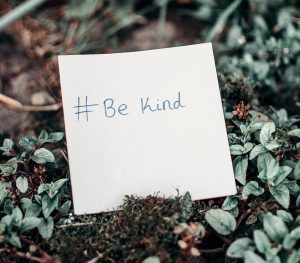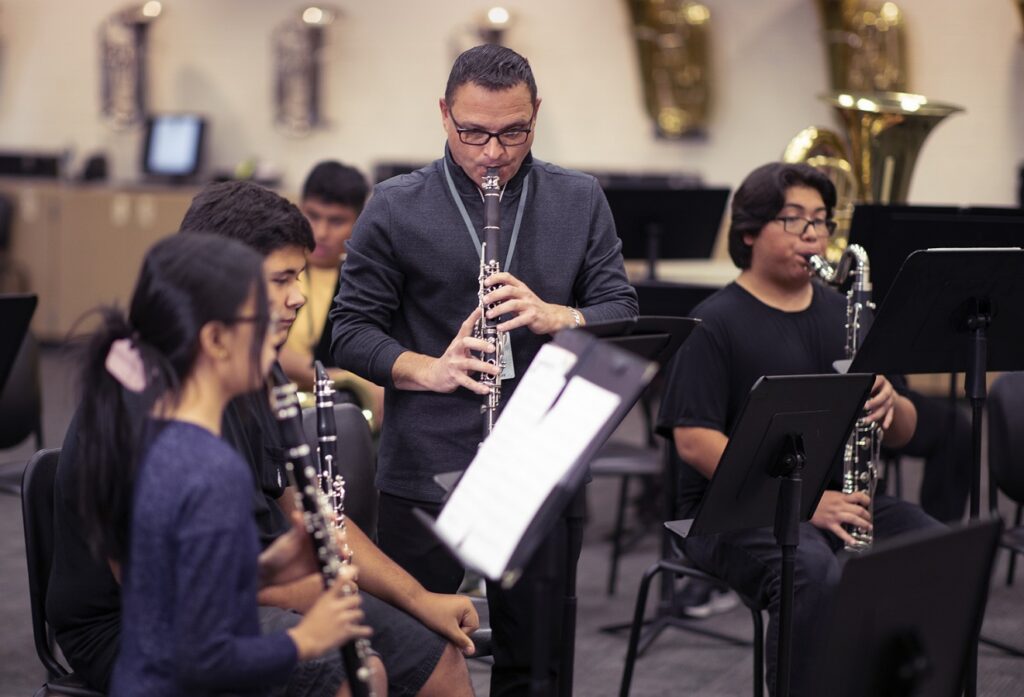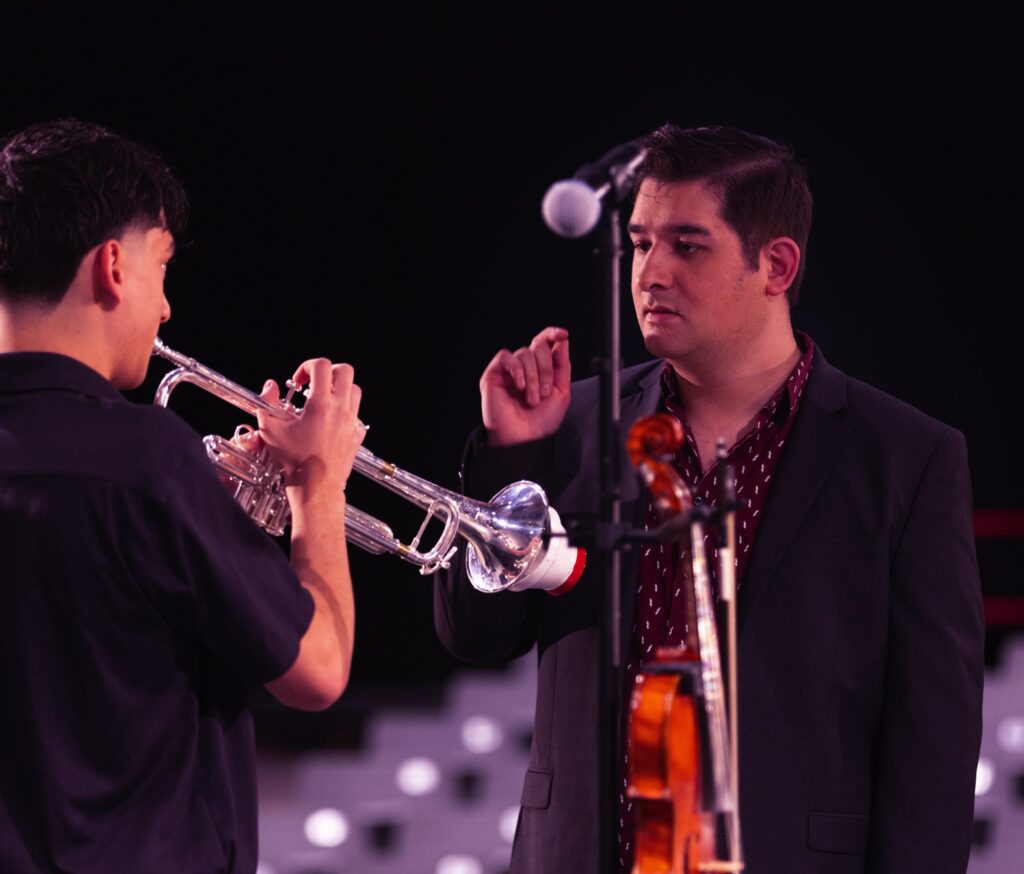Caring Comes in Many Forms
With the recent and much-needed push to be kinder, teachers must balance caring with delivering feedback in a positive way.
It stings every time I hear a student say, “Mr. Stinson just doesn’t care about me!”
And hearing it always puts me into a time machine and takes me back to my time as a student. My teachers were tough on me. I thought some were mean. Turns out they were just honest!
I remember lamenting, “My English teacher yelled at me today!”
As I look back, I realize that he never yelled. He just said something I didn’t like.
Teacher Types
Some of your students may need a different delivery style. Perhaps they may benefit from one or a combination of the following archetypes:
 The Tough Teacher: This is the teacher who kids dread seeing, but the one they think about when they’re adults. These teachers are like Batman — the hero that they deserved but not the one they thought they needed at the time. As students, we resist these teachers because they take us out of our educational comfort zone. Then one night when we’re in our 20s, 30s, 40s or older, we wake up and think, “They were right.”
The Tough Teacher: This is the teacher who kids dread seeing, but the one they think about when they’re adults. These teachers are like Batman — the hero that they deserved but not the one they thought they needed at the time. As students, we resist these teachers because they take us out of our educational comfort zone. Then one night when we’re in our 20s, 30s, 40s or older, we wake up and think, “They were right.”
The Friendly Teacher: These teachers just know how to connect with kids. They greet everyone with a smile and usually stay upbeat no matter what. They truly listen to kids, but they aren’t pushovers. Their genuine interest in what activities a student participates in or what video games they are into provides an avenue into building a positive classroom culture that promotes learning.
The Proactive Teacher: The ability to see the future comes with responsibility, but it can also eliminate some stressful situations. Proactive teachers thrive on preventive maintenance. They have experienced some things or witnessed others’ experiences, and they provide guidance and maintenance based on what could happen with certain decisions. At the same time, they still encourage students to make their own choices. This teacher works extremely well when paired with a sage/mentor type.
The Reactive Teacher: The go-with-the-flow teacher allows students to have certain experiences that won’t completely break them but that will bend them a little bit. These teachers then react to the situation. The best of them slow down, determine if something is actually an emergency or not, and then make their decisions to the best of their ability. Their classrooms are often spontaneous and lend themselves to a lot of surprise learning that is remembered for years.
The Involved Guide: These teachers often can relate to a specific student. That particular student often becomes magnetically attached to this teacher and looks to them for guidance in many areas of his/her life.
 The Sage or Mentor: You know these teachers — the ones who drop in with a one liner that you’ll never forget. Sages are similar to the tough teacher, but their timing is impeccable. They have an air of mystery — you don’t interact with them a lot, but when you do, you know something impactful is about to happen. Some of the most profound advice and teachings I have received were from people I rarely saw.
The Sage or Mentor: You know these teachers — the ones who drop in with a one liner that you’ll never forget. Sages are similar to the tough teacher, but their timing is impeccable. They have an air of mystery — you don’t interact with them a lot, but when you do, you know something impactful is about to happen. Some of the most profound advice and teachings I have received were from people I rarely saw.
The Relator: Understanding what someone is going through and relating to them can be a powerful way to let people know that they are not alone. However, we must be careful to not completely negate their experience. There is a fine line between relating to someone to let them know that you understand and support them, and marginalizing their experience. The relator is there to let kids know that they are not alone. These teachers do a great job of packaging significant experiences into easily digestible segments that can help guide a student through tough times. These educators let their students know that teachers are human, too, and can help out with situations outside of reading, writing and arithmetic.
The Authoritarian: Authortiy is not a bad word. Authoritarian teachers care by showing students that rules and discipline can make a positive difference in one’s life. These teachers can be similar to the tough teacher but may have a less personalized approach through utilizing consistent routines, structures and methods in their teaching. The authoritarian cares by showing students that consistent expectations apply to everyone, but behind the scenes, they carefully craft goals that their students can achieve.
How Do We Care?
 In recent years, we’ve had a much-needed push toward being kinder — this is great! However, I’ve noticed that some people begin confuse kindness with being unable to deliver direct feedback when needed. As teachers, we can be just as concerned with being fair and insistent as we are with being kind or nice.
In recent years, we’ve had a much-needed push toward being kinder — this is great! However, I’ve noticed that some people begin confuse kindness with being unable to deliver direct feedback when needed. As teachers, we can be just as concerned with being fair and insistent as we are with being kind or nice.
When we’re kind, we show concern for others’ feelings and different situations. Yet, we can also do our students justice (and show kindness) by working to get the best out of them. In other words, I can be kind but that doesn’t mean I let students take advantage of systems or not allow them to reach their full potential.
Here are some ways to show students that we care:
- by checking in with them, but also not letting them use excuses for working hard.
- by not letting them settle for their very least.
- by insisting that they show up on time.
- by treating them fairly, but also explaining that the world won’t always do the same.
- by not moving obstacles in their way; rather, by helping them build the tools to go around, over or even to destroy those obstacles. Eventually, we want students to welcome that obstacle, befriend it and understand that the obstacle is a gift.
- by helping them see that if we say yes to their request to be late or receive special treatment, we may be saying no to everyone else.
- by making challenging decisions that do not make sense right now, but that they will hopefully appreciate later.
More than Just a Note
Several years ago, I started writing a personal note on the concert program for each student. I originally did this for retention; I thought if I was nice to the kids, they’d stay in band. I took the concert programs home, wrote a note to each student, and handed them out on the day of the concert. These were simple notes:
- “Bobby — good luck today! I’ve enjoyed hearing your progress!”
- “Maria — you’re why everyone wants to play bassoon. Thanks for being a great role model!”
 The first year I wrote these notes, I had 40 students in the band. The next year, I had 75, and eventually, I had 120. At this point, I was looking forward to not writing these notes anymore. Two days before our first concert, a freshman band member came to me after rehearsal and said, “Mr. Stinson, I can’t wait to see what you write on my concert program! We kept hearing in junior high that everyone gets one!”
The first year I wrote these notes, I had 40 students in the band. The next year, I had 75, and eventually, I had 120. At this point, I was looking forward to not writing these notes anymore. Two days before our first concert, a freshman band member came to me after rehearsal and said, “Mr. Stinson, I can’t wait to see what you write on my concert program! We kept hearing in junior high that everyone gets one!”
I smiled through gritted teeth and said, “Just wait and see!” I loaded a box of programs into my car and spent the better part of the night writing out programs with the TV on in the background. Years later, these personal notes have become a tradition that I’ve carried to each school for each performance. At the very least, it’s a small gesture to show students that their time is appreciated. At most, it might be the only note of encouragement that some of our students get. Most of them take the programs home or keep them in their folders. A few end up on the floor after the concert, but I hope the message came across authentically.
Teacher time-saving trick: A bonus is that you can combine handing out these programs and taking attendance for the concert. We always think of those time-savers!
I’ve talked with some students after they graduated from high school, and most have brought up these program notes. Turned out, the notes encouraged participation, fostered growth and even stopped a few kids from quitting school music. One student was planning to leave band and do something else for her senior year. I wrote in the May concert program that I enjoyed working with her and hoped that she would come back for some alumni events. I truly meant this message. After the concert, she was bawling and asked if we still had a spot for her the next year. Of course, we did.
Showing Care While Being Direct
It’s OK to be direct, provided that we are fair and not belittling anyone. I work mainly with students from low-income families. Since I grew up in a similiar situation, I am perfectly comfortable using my “street cred” with my students. I know that I can be more direct with some students as opposed to others. This is where relationships and knowledge of students are key to effective instructional delivery.
Think about some of your band members and how they would best react to feedback. Maybe they work best when they are not called out directly: “Someone in the clarinet section is playing sharp. Make sure to lower your tongue a little bit.”
Others may require another approach. A statement like “I think there is something off with the clarinet intonation in measure 21” with a look in the general direction may get the job done.
And some students may appreciate a direct and succinct approach. “Laura, you’re sharp. Please fix this.” This is direct but polite and shows that we trust Laura to get the job done.
I was once accused of not caring about some students because I was too tough on them. I took this to heart and changed to this tiered approach.
 Balance
Balance
Most of us operate primarily within our personality type. But sometimes, it helps to stray a little bit. For example, the overly caring teacher who occasionally has to be firm sends a message that yes, they are usually patient but that doesn’t mean you can treat them poorly.
Conversely, the stern and tough teacher who occasionally opens up and offers a glimpse into the puppy dogs and rainbows that are really in their soul can also show kids the balance and different sides that we all have. Too much of one style can become ineffective.
What Not Caring Looks Like
It might help if we take a look at situations where we’re apathetic about something small. For example, if you see a candy wrapper on the floor of your school’s hallway and don’t pick it up, what message are you sending?
- You don’t care about cleanliness.
- You think that someone else should have picked it up and thrown it away.
- It’s someone else’s job.
In my music classroom, a small example of not caring might be hearing a passage played with incorrect articulation and not addressing it. A significant example might be encouraging a student to drop your class because he or she is just too difficult to work with.
 Other examples may have a more layered effect. If we don’t care about poor behavior, then we may be sending a message that we don’t care about the kids who are contributing positively. These students may then wonder what’s the point in contributing to a system that may end up having diminishing returns.
Other examples may have a more layered effect. If we don’t care about poor behavior, then we may be sending a message that we don’t care about the kids who are contributing positively. These students may then wonder what’s the point in contributing to a system that may end up having diminishing returns.
You might be thinking, “So, Don, you expect me to care about fixing every fine detail, keep kids in music who want to quit, and also pick up trash?”
Not exactly.
You only have so much energy, and being pulled in too many directions can get you to the point where you’re not caring about yourself as much as you should. I offer these suggestions about caring as merely points to think about.
When I think about the teachers who cared about me when I was a teenager, I realized that they didn’t just care about their students. They also cared about their space, their presentation and the messages they sent. I regularly reflect on the mistakes I’ve made to help me focus on where my care goes because care and kindness go a long way.















